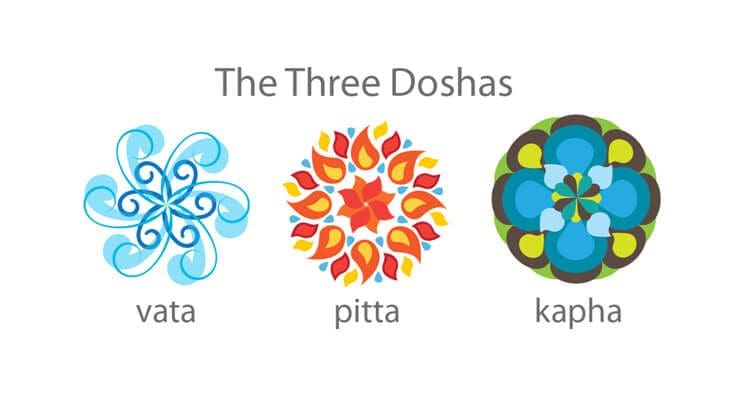
Ayurvedic Medicine
Discover Your Dosha, Part 1
Ayurvedic medicine is much more than just medicine. This 5,000-year-old practice began in India and has since spread across the world, shaping and improving the lives of many people all over the world.
The core focus of Ayurveda is on prevention. It’s based on the concept that general health and wellness rely on a delicate balance between mind, body, and spirit.
In Ayurvedic medicine, balance is everything — and it’s achieved by harmonizing the three doshas: vata, pitta, and kapha.
The ancient health science of Ayurveda is built around the five elements of ether, air, fire, water, and earth. The unique combination of these elements come together to make up the doshas, or constitutions.
Each dosha has a number of corresponding qualities that are expressed in the physical, emotional and mental aspects of one’s being. All of us have some aspects of each dosha, but one or two doshas tend to be predominant, giving us information about everything that happens in our bodies, from our digestion to even our emotions.
As I mentioned before, the three doshas are represented in everybody but in different amounts. Some people may have a constitution that is more dominant in pitta, while another may be more like a vata-pitta dominance.
The idea is that by knowing your body and knowing what to do to balance yourself, you can get all of your doshas back to harmony, and hence, to health.
Dosha quiz
Take this quiz to discover your dosha. In the next issue of Howler, I will talk about how to interpret your results!
- Which of these best describes your physical frame?
- Small
- Medium
- Large
2. Which best describes your skin?
- Oily and soft with freckles or pimples
- Thick, oily, cool skin
- Dry
3. Which best describes your hair?
- Straight and fine
- Thick and lustrous
- Dry and curly
4. Which best describes your eyes?
- Large, pretty
- Small and dry
- Medium-sized; intense gaze
5. Which best describes how you talk?
- Fast and/or a lot!
- My words are sharp and concise.
- My speech is slow and calm.
6. What type of weather is your favorite?
- Warm
- Cool
- Cool and dry
7. How is your memory?
- I learn quickly, but I also forget quickly.
- I have a great memory!
- It takes me a while to commit something to memory, but once I do I don’t forget it.
8. Which best describes your personality?
- Responsible, nurturing, and sensitive
- Creative, joyful, and introspective
- Competitive, perceptive, and efficient
9. Which of these traits do you most identify with?
- I can be pretty stubborn.
- I get jealous easily.
- I’m often indecisive.
10. How about these traits? Which sounds the most like you?
- I’m very intuitive.
- I’m quite brave.
- I’m a loyal, faithful friend.
11. And these? Which sounds the most like you?
- I’m often restless.
- I can be irritable and impatient.
- I’m a loyal, faithful friend.
Write down how many a, b, and c answers you have of each. Notice if you have a predominant letter.
A predominant: Vata
B predominant: Pitta
C predominant: Kapha
Once you know your dosha — the one with the highest number — you can read all about it in my next article.
Three Energies, Five Elements, Part 2
Following last month’s introductory Howler article on this topic, today we will continue learning more about Ayurvedic medicine.
It is said that in order to achieve all four pillars of light, a person must have a healthy body, mind, prana (vital energy), and consciousness. These can be achieved by applying Ayurvedic principles in your daily life.
Ayurveda is an inherent healing system that includes: panchakarma (cleansing), rejuvenation, herbs, and a proper diet and lifestyle regimen.
Ayurveda identifies three basic types of energy, or functional principles, that are present in everything and in every body. These principles can be related to the basic biology of the body: vata, pitta and kapha.
Energy is required to create movement so that fluids and nutrients get to the cells, enabling the body to function. Energy is also required to metabolize the nutrients in the cells, and is called for to lubricate and maintain the structure of the cell. Those energies are:
- Vata — the energy of movement
- Pitta — the energy of digestion or metabolism
- Kapha — the energy of lubrication and structure
All people have the qualities of vata, pitta and kapha. But usually one is primary, one secondary and the third least prominent.
The cause of disease in Ayurveda is viewed as a lack of proper cellular function due to an excess or deficiency of vata, pitta or kapha. Disease can also be caused by the presence of toxins.
Your constitution and Its inner balance
Ayurveda places great importance on prevention and encourages the maintenance of health through balance in one’s life, right thinking, diet, lifestyle and the use of herbs.
Examples of factors that disturb this balance are one’s emotional state, diet and food choices, seasons and weather, physical trauma, work, and family relationships.
Balance is the natural order; imbalance is disorder. Health is order; disease is disorder. Makes sense, right? So, when one understands the nature and structure of disorder, one can re-establish order.
According to Ayurvedic philosophy the entire cosmos is an interplay of the energies of the five great elements — space, air, fire, water and earth. Vata, pitta and kapha are combinations of these five elements that manifest as patterns present in all creation.
Vata, the subtle energy associated with movement, is composed of space and air. It governs breathing, blinking, muscle and tissue movement, pulsation of the heart, and all movements in the cytoplasm and cell membranes. In balance, vata promotes creativity and flexibility. Out of balance, vata produces fear and anxiety.
Pitta, expressing as the body’s metabolic system is made up of fire and water. It governs digestion, absorption, assimilation, nutrition, metabolism and body temperature. In balance, pitta promotes understanding and intelligence. Out of balance, pitta arouses anger, hatred and jealousy.
Kapha, as the energy that forms the body’s structure — bones, muscles, tendons — provides the “glue” that holds the cells together, formed from earth and water. Kapha supplies the water for all bodily parts and systems. It lubricates joints, moisturizes the skin and maintains immunity. In balance, kapha is expressed as love, calmness and forgiveness. Out of balance, it leads to attachment, greed and envy.
Do you remember, from taking the quiz in our last article, what your main dosha is? If you need to refresh your memory, or haven’t taken the quiz yet, be sure to answer the questions before next month’s follow-up article. Find me in the August issue of Howler to tell you more about how to understand your primary dosha and how to keep it balanced!

